I tried 3 celebrity chefs' blueberry muffin recipes, and the best one was the easiest to make
Paige Bennett

- I followed three different blueberry muffin recipes from celebrity chefs Ina Garten, Alton Brown, and Paula Deen to see which one produced the best results.
- The muffins I made using Alton Brown's recipe didn't turn out quite right, and the final result was just OK.
- The blueberry muffins I baked according to Paula Deen's recipe were dry and bland.
- Ina Garten's recipe was easy to follow and it produced the most delicious, fresh-tasting results.
- Visit Insider's homepage for more stories.
Blueberry muffins are tasty any time of day, but rather than turning to prepackaged mix, you can have fresh, homemade ones by using simple ingredients — just ask the pros.
To find the best blueberry muffins, I tested recipes from celebrity chefs Ina Garten, Alton Brown, and Paula Deen.
Here's how each batch of muffins turned out, plus which one you should try the next time you're craving a sweet breakfast.
Read the original article on InsiderThe muffins I made using Garten's recipe were the best — but with a few tweaks, I think the other recipes could be great.
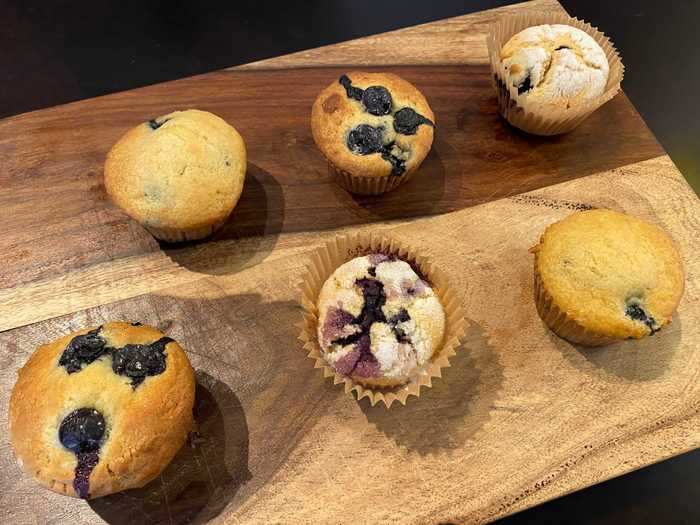
Garten's blueberry muffin recipe was definitely my favorite. It was easy to whip up and had a pleasant texture and fresh flavor.
In the future, I would actually pull a page from Brown's book and toss the blueberries in flour and cornstarch to keep them from sinking to the bottom.
As I mentioned earlier, I experimented with Brown's recipe a bit more after the first round, and I found a few things to change to make them work better with my oven and my taste buds. Namely, not putting the blueberries on top and keeping the oven at a lower temperature could make the resulting batch even better.
For Deen's muffins, it seems they could use more liquid to help prevent them from drying out while baking. I also would use far less sugar on top and more sugar in the batter for a more consistently sweet flavor.
For all of the recipes, I'd recommend adding more lemon zest, because it tastes incredible with blueberries.
Read More:
- I made banana bread using 4 different celebrity recipes, and the best one was the easiest to make
- I made French toast using 3 celebrity chefs' signature recipes, and the best one cost over $40 to make
- I made brownies using 3 different celebrity-chef recipes, and the best one was also the most fun to bake
- I made deviled eggs using 3 celebrity chefs' recipes, and the best ones were the cheapest to make
These muffins just missed the mark.
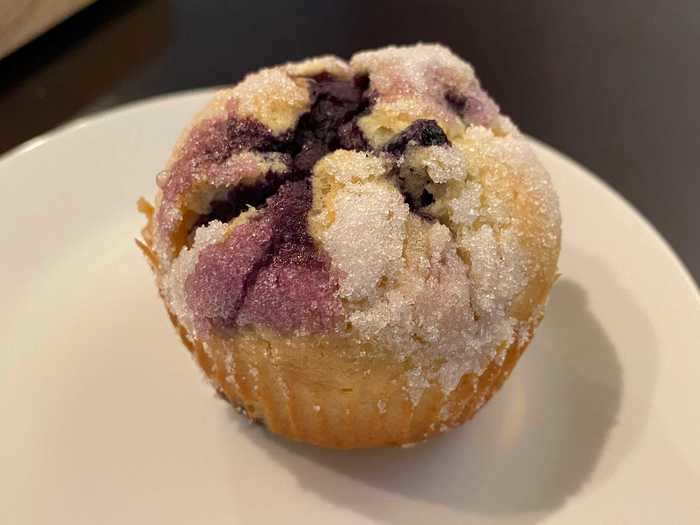
The texture of the muffins was like overly dry cornbread, and when I bit into the muffin, the sugar on top sprayed out everywhere because it didn't set into the muffins.
Unfortunately, the taste wasn't quite there for me, either. The flavor was rather bland — likely because, aside from the sugar on top, the actual muffin wasn't sweet at all.
These muffins were dry and messy.
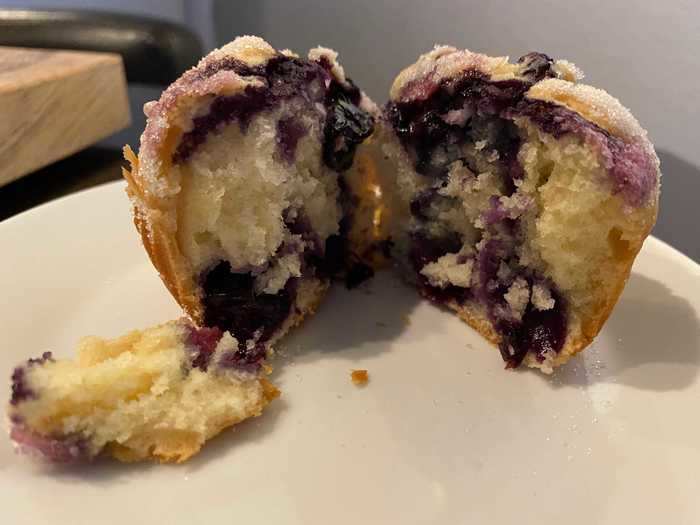
The sugar didn't turn brown in the slightest — instead, it sat atop the muffins looking just as it did when I first poured it on top of the batter.
I'm not sure why these muffins didn't cook properly. But after reading some of the comments on the recipe, I learned that I am not alone in my strange results.
Many others who say they followed Deen's recipe found the muffins to have an odd, dry texture and bitter taste.
The process was simple, but it produced some strange results.
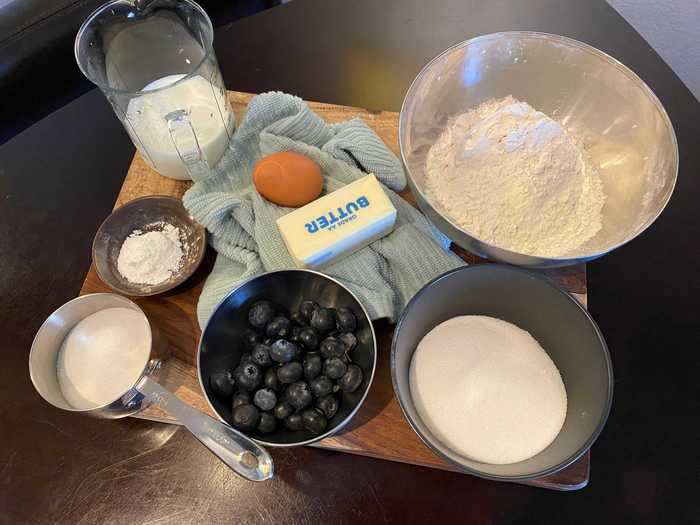
After scooping my batter into a muffin tin, I grabbed the recipe's recommended ½ cup of sugar to top the muffins with.
I love to add a sprinkle of sugar on top of muffins for an added crunch, but ½ cup among 12 muffins seemed really excessive. I added a lot of sugar to each muffin, but still didn't come close to using the entire ½ cup.
The excessive sugar topping seemed to slow the cooking process in the oven — or something was lacking overall in the recipe — because the muffins took far longer in the oven than what Deen suggested.
I kept them in the oven for the maximum recommendation of 25 minutes and they were very light in color and far from cooked. At 35 minutes, they were still pale and began to look dry.
I left them in, hoping they would reach the golden color the recipe calls for. By 40 minutes, they had the slightest golden color to them, so I took them out to prevent them from becoming dried out.
Paula Deen's muffin recipe started off promising, with few ingredients and simple directions.

Deen's blueberry muffin recipe called for common baking ingredients: flour, baking powder, milk, sugar, butter, and egg.
Like any classic recipe, Deen's directions include mixing the wet ingredients, then the dry. Then, you simply add the wet to the dry, mix, and fold in the blueberries. This seemed easy enough.
The muffins were OK, but I made some changes and tried again.
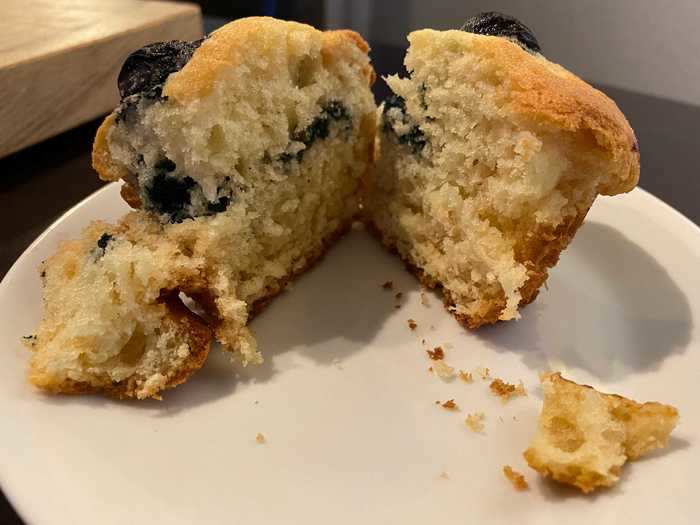
When I cut a muffin in half, the knife went through smoothly but stuck on the bottom a bit. This told me that the muffins were overcooked on the edges and the bottom.
I took a bite and tasted the slightly acrid taste of burnt food on the edges, which was disappointing. The edges were also crunchy, a giveaway of their overcooking.
I ended up trying this recipe once more. I decided I'd rather throw all of the blueberries in the batter since the fruit reserved for topping ended up coated in the flour mixture.
I also left the oven temperature at 380 degrees Fahrenheit instead of increasing it and pushed the blueberries on top further into the batter.
The muffins cooked much more evenly, and I was pleased with the results, although they weren't quite a result of Brown's instructions.
The blueberries didn't sink, but something seemed off about these muffins.
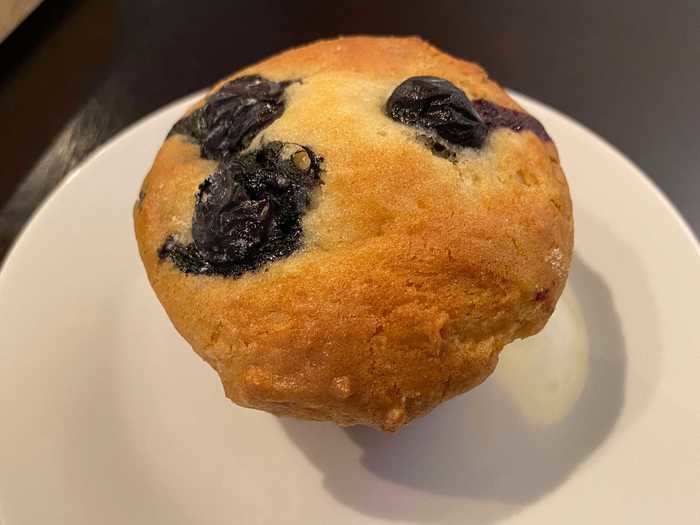
The top blueberries were beautifully oozing across the muffins after baking, but they still had a fairly heavy dusting of the dry flour mixture they were tossed in so I tried to brush most of it off.
That aside, the muffin was light and fluffy, and sweet without being overly so.
No blueberries sunk to the bottom of the muffin because the cornstarch and flour mixture actually soaked up some of the berries' liquid during baking. This helped prevent them from sinking down in the batter.
These muffins didn't go quite as planned.
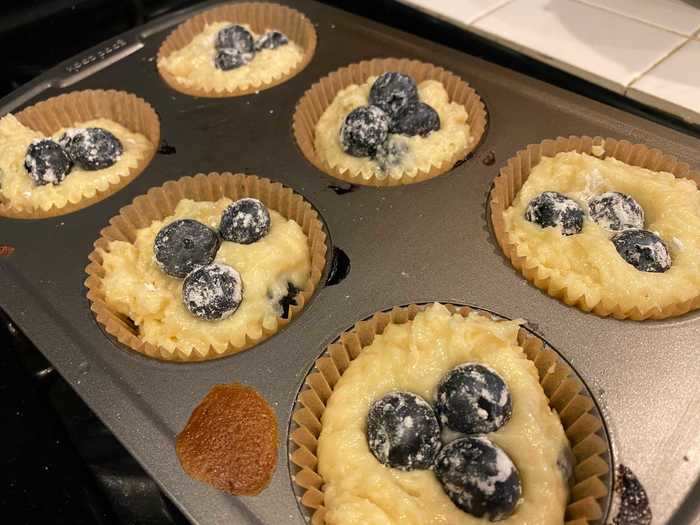
The recipe told me to change the oven temperature from 380 degrees Fahrenheit to 400 degrees Fahrenheit midway through baking.
But by increasing the oven temperature, I found that the muffins started looking and smelling slightly burnt after just 15 minutes.
By the recommended 25 minutes, they looked quite dark on the edges (just shy of burnt), yet pale and slightly undercooked in the center. The toothpick test determined they were done, but I was worried something had gone wrong.
The baking process was complex and precise.
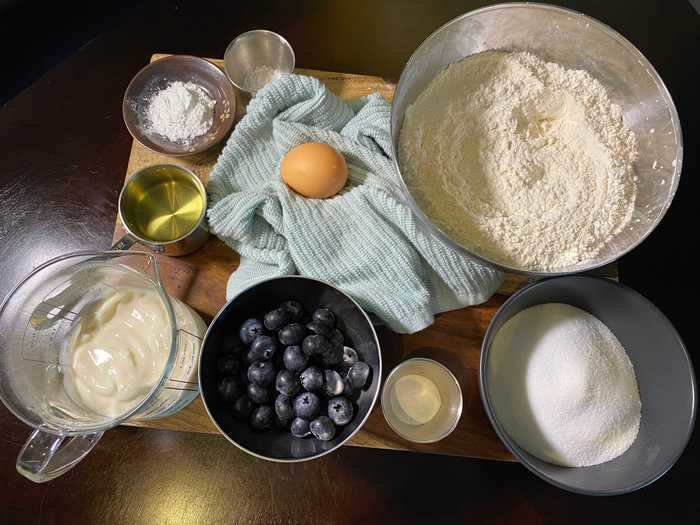
In true Brown fashion, the directions were very specific. I was a little nervous at every step, worried I wasn't being precise enough.
Brown even requests stirring the muffin mixture a total of 13 times. After 13 stirs, my mixture wasn't combined nearly enough so I kept going for a little bit longer.
From there, I reserved some blueberries for topping and tossed them in a tablespoon of the dry ingredients. These blueberries were then placed on top of the muffins just before they went in the oven.
Alton Brown's recipe called for simple ingredients and very specific measurements.

Alton Brown's ingredients list was also rather simple and called for several pantry staples.
The recipe specifically called for cake flour, which I couldn't find. Luckily, I easily made my own substitute by mixing all-purpose flour with cornstarch.
Since the recipe measures the flour in ounces rather than cups, it is important to have a kitchen scale to get this recipe just right. Brown is known for his scientific methods of cooking and baking, so I knew using a scale would be important to get precise measurements.
Still, it was love at first bite.
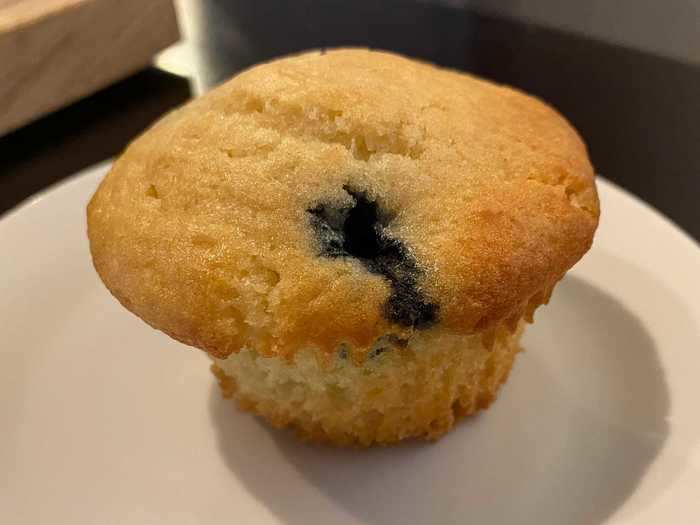
I loved the fresh taste of these simple muffins.
I immediately picked up on the lemon zest, and the vibrant, acidic citrus flavor cut through some of the sweetness of the blueberries for a well-balanced taste overall.
It was also perfectly sweet, and I think the inclusion of buttermilk added a slight tanginess and gave the muffin that nice, moist texture.
The muffins looked good, but the blueberries sank.
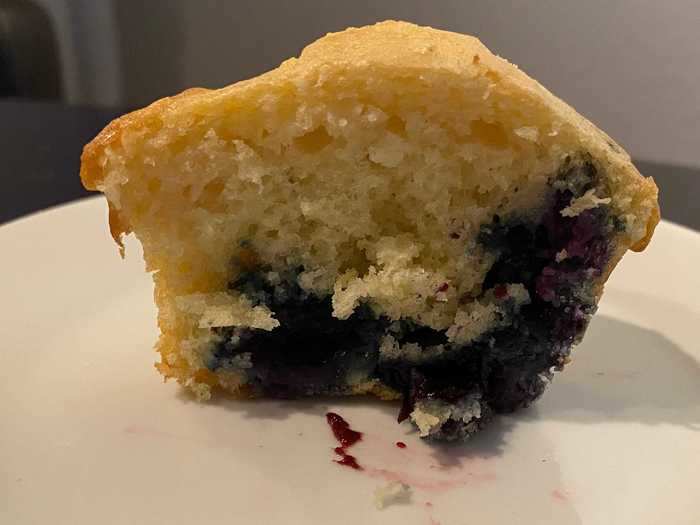
The resulting muffins were perfectly golden from top to bottom. When I cut one in half to check the texture and interior appearance, I found a very fluffy, moist muffin.
Unfortunately, I noticed that most of the blueberries sank to the bottom, which made the muffin a little too moist and it sort of fell apart.
The baking process surprised me a bit.
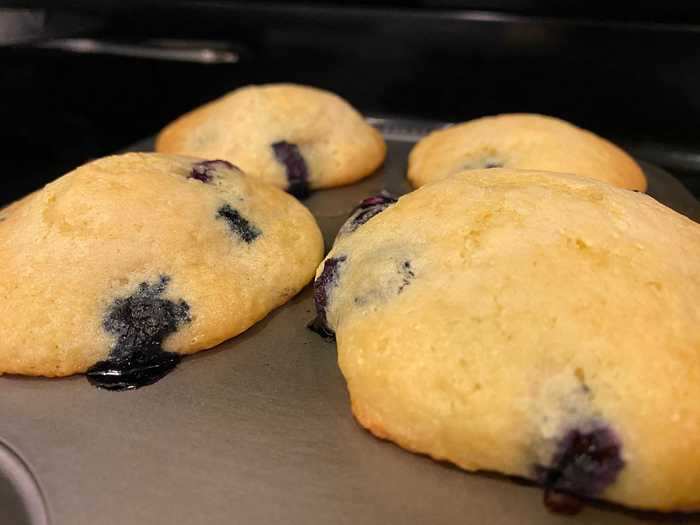
I checked on my muffins at the 20-minute mark, and they looked pale and far from being cooked. Just to be safe, I added only four more minutes to my timer.
In those four minutes, the muffins went from pale to golden brown, and a toothpick came out clean when I inserted it to check if the muffins were done. If you follow this recipe, be sure to frequently check your muffins, since they can go from undercooked to burnt in no time.
Thankfully, 24 minutes seemed to be the sweet spot, and I pulled them out at the perfect moment.
The recipe was easy to follow and smelled delicious while baking.
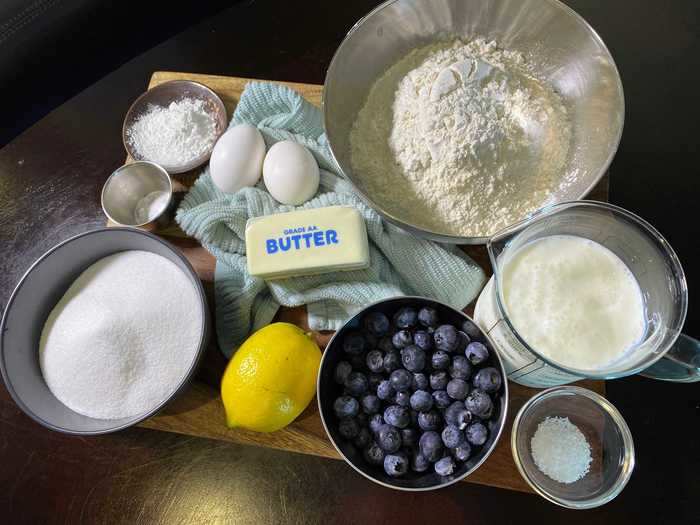
Perhaps even simpler than the ingredients was the process to make the muffins. I just mixed together the dry ingredients, such as flour, sugar, baking power, baking soda, and salt.
Then, in a separate bowl, I combined the wet ingredients: buttermilk, butter, eggs, and lemon zest.
I carefully added the wet ingredients to the dry mixture, making sure to not overmix the batter while folding in the blueberries.
Ina Garten’s recipe called for simple, fresh ingredients.

I kicked things off with this simple recipe from Ina Garten. I had a feeling these would be a hit thanks to one simple, fresh ingredient: lemon zest.
I love the flavor combination of blueberries and lemon, so I figured these muffins would have a bright flavor profile.
READ MORE ARTICLES ON
Popular Right Now
Popular Keywords
Advertisement